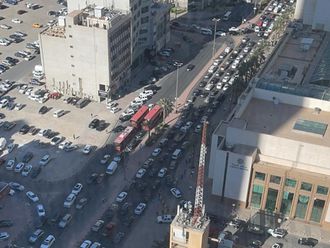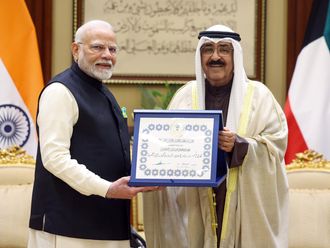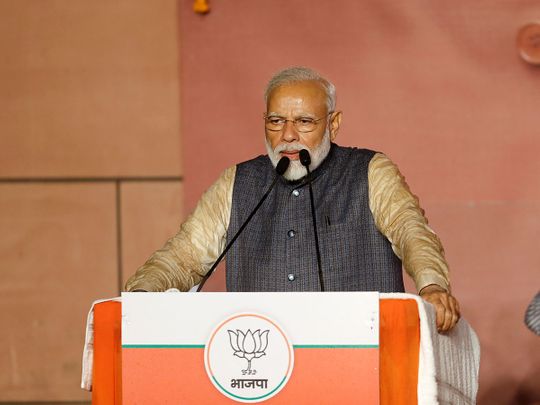
What has led to a saffron wave in India. Why did the Congress fail? What caused the Mahagathbandan to to collapse? Gulf News brings you the analysis.
The Congress thought it had swung the verdict for 2019… till it got 54 seats
By Chiranjib Sengupta, Assistant Editor
In search of the truth, India’s opposition Congress party was always going to end up the sore loser in the 2019 race.
Congress president Rahul Gandhi told jittery party workers on Wednesday not to be scared of what he called “fake exit polls,” since they were all “fighting for the truth”.
This was the biggest fallacy of the bruising Indian election campaign in 2019.
Rahul’s assumption marked the fatal error not only with the Congress campaign, but the entire Opposition campaign.
While the Congress party was busy running a “nice” campaign with a manifesto full of good intentions and socially relevant schemes, and its Opposition allies were harping on the BJP’s abject failure in delivering its campaign promises from 2014, Prime Minister Narendra Modi and his party were relishing their role as storytellers and harbingers of a golden future for India.

In this backdrop of a post-truth world obsessed with the repeated assertions of alternate reality, came Pulwama and Balakot.
Let us recall that by the beginning of the year, the BJP was faced with a mountain to climb ahead of the elections: farmers’ distress; a jobs crisis; Rafael controversy and allegations of corruption. But the Pulwama attacks and India’s subsequent retaliation in Balakot provided Modi and party president Amit Shah the perfect narrative to rewrite the BJP’s script.
In a world where the ordinary voter is more than willing to suspend belief, social media chatter about the Prime Minister’s analysis of the cloud-cover on the fateful night of the Balakot operations, or the opposition’s clamor for proof following it, or the travails of their daily life and the issues that surround it, all died down eventually.
What remained ingrained in the voter’s mind is the narrative of a muscular India and the man helming it: Narendra Modi.
Even the Congress party is a beneficiary of this post-truth legacy, perhaps without realizing it.
Congress party advisor Sam Pitroda committed political hara-kiri with his dismissive comments about the Sikh massacre of 1984 during the heated campaign. But the Congress party still reaped handsome rewards off Captain Amarinder Singh’s tactical stewardship in Punjab. Singh successfully managed to wean voters off the wounds of 1984 by constantly invoking his fellow Faujis (former servicemen) and reminding everyone about the 2015 Behbal Kalan and Kotkapura firing incidents. The result of that suspension of belief is out today, with the Congress party on the way to win eight out of 13 parliament seats in Punjab.
Nationally, the Congress and the rest of the opposition have now crash-landed in this post-truth reality – how they handle it will decide the fate of Indian democracy in the coming years.
BJP consolidation continues in central India
By Sanjib Kumar Das, Senior Pages Editor
In vast swathes of central India, the Bharatiya Janata Party (BJP) has come up with a stellar show -- the story in no way different from what has been unfolding in western, northern and eastern India since early morning on Thursday as counting began.
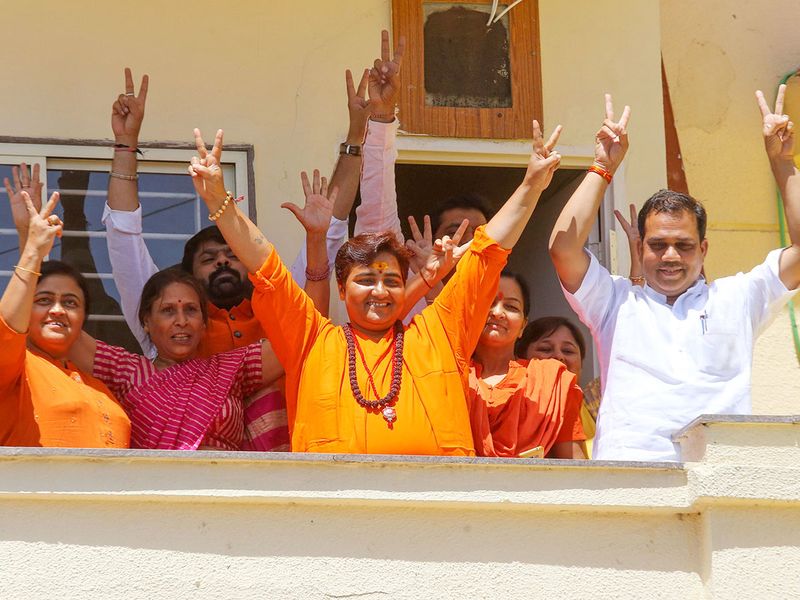
In the central Indian state of Madhya Pradesh, a state that had thrown a BJP government out of power and brought the Congress party in barely six months ago, voters have opted to go with the ‘Narendra Modi wave’ and how. Out of a total of 29 seats in the state, until reports last came in, BJP was ahead in 28, while Congress won one seat – Chhindwara – but wasn’t ahead in any of the other seats in the state. Even senior Congress leader and former chief minister Digvijay Singh was trailing by a margin 260,000 votes in Bhopal, until reports last came in. If Digvijay loses, it will be a huge blow to the morale of the Congress party and Chief Minister Kamal Nath.
In Chhattisgarh, BJP candidates were ahead in ten out of the state’s 11 seats – yet another state where Congress had come to power barely six months ago. In Jharkhand, the trend holds, with BJP ahead in 12 out of the 14 seats until reports last came in.
Why Kerala stopped the BJP surge
By Shyam A. Krishna, Opinion Editor
The BJP may be the election behemoth in most parts of India. That does not hold true south of the country. More so in Kerala, where the right-wing party has been struggling to gain a foothold. It did win a seat (Nemom) in the 2016 Assembly elections through veteran O. Rajagopal. That victory gave rise to hopes that were crushed in the parliamentary election.
Why did Kerala stop the BJP? Where did the BJP go wrong? The Sabarimala Temple controversy was a perfect fodder for them. And the BJP used it to whip up public anger and widespread resentment. Evidently their attempts did not translate into votes.
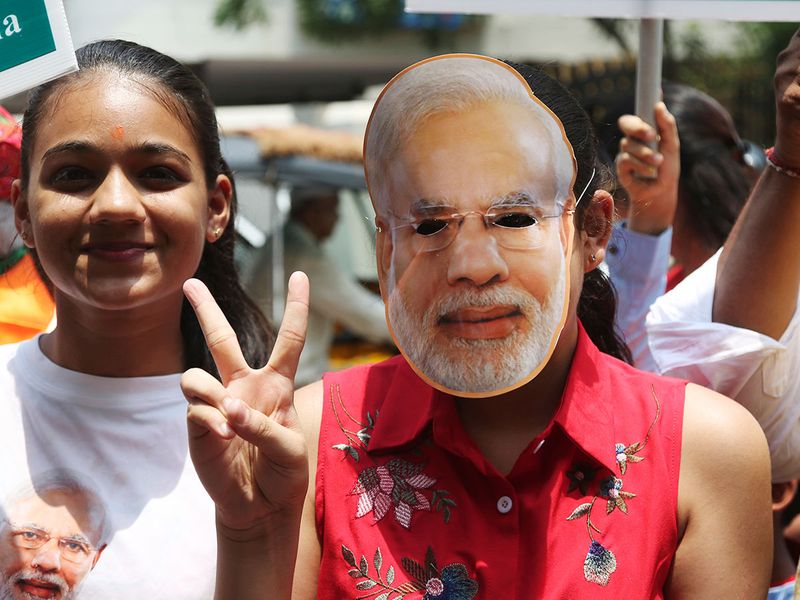
Perhaps, the answer lies in their literacy. People in the most literate state of India are very politically aware. Their political consciousness is reflected in the polling, which consistently hovers near the 70 per cent mark for all elections (The turnout for this election was 77.68 per cent). A literate person is not easily swayed by the agendas of political parties.
BJP’s Hindutva agenda never sat well with the Keralites. Violence unleashed by right-wing elements in the north had the Christians, Muslims and other minorities in Kerala cowering in fear. The liberal Hindus too have been unnerved. Keralites wouldn’t want such unsavoury episodes in their state.
All these years Keralites have known only two fronts – the United Democratic Front, led by Congress, and the Left Democratic Front, led by the Communist Party of India (Marxist). For them, the BJP-led by National Democratic Alliance is a relatively new entity. And their governance at the centre and other states in India haven’t engendered any confidence. In fact, it has only spawned fear.
People in God’s Own Country want to live without fear.
Kerala stalls the saffron wave
By Shyam A. Krishna, Opinion Editor
As the BJP storms to a landslide in India, Kerala is one of the few states of that seems to have been untouched by the saffron wave. The BJP were expected to post their maiden win in this southern state through their former Kerala party president Kummanam Rajasekharan. Even the exit polls predicted it. But Shashi Tharoor scrubbed out such hopes. He rode on the Congress momentum in the state to put himself on a hat-trick of wins at the Thiruvananthapuram North constituency.
Pathanamthitta was another constituency that held out hopes for the BJP, since it was the epicentre of protests that erupted following the Supreme Court decision to allow menstruating women to pray at the Sabarimala Temple. The protests, and the BJP attempts to cash in on the controversy, don’t seemed to have had any effect on the electorate. K. Surendran, who spearheaded the protests, is languishing in the third spot, behind Anto Antony (Congress) and Veena George (CPM).
Actor Suresh Gopi was another BJP stalwart who failed make an impact. He is trailing in third position with T.N. Prathapan (Congress) and Rajaji Mathew Thomas (CPI).
Meanwhile, Congress-led United Democratic Front looks set to win 19 seats in Kerala, while and the Marxists (CPM) may win only the Alappuzha seat
Bengal’s tribal belt goes with saffron wave
By Sanjib Kumar Das, Senior Pages Editor
One of the most interesting facts about these elections in West Bengal is the way the vote in the tribal belt has consolidated against the ruling Trinamool Congress (TMC) and in favour of Bharatiya Janata Party (BJP). With BJP set to do well in seats such as Purulia and Jhargram, the saffron brigade has been able to make very steady inroads into a state that has traditionally been averse to any rightist agenda.
Added to that is the BJP’s exponentially rising vote share in Bengal. From its erstwhile best-ever showing of a 17 per cent vote share in the 2014 general elections, the BJP stands to garner anywhere around 43 per cent this time! And this rising vote share is most likely to boost the party’s tally to around 17 seats -- something unthinkable until about a few months ago.
While BJP has always lacked in organisational strength in the state, Chief Minister Mamata Banerjee’s trusted former political aide Mukul Roy switching over to BJP about a year-and-a-half ago has helped BJP have some invaluable inputs on managing what in popular jargon is often referred to as the ‘vote machinery’. That has come in handy for the party in Bengal’s hinterlands this time around.
If leads are anything to go by then BJP may go on to win the prestigious Kolkata South seat, considered to be Mamata’s backyard – a seat that TMC hasn’t lost since 1996 and from where Mamata herself had been elected to the parliament several times in the past. Should BJP go on to win that seat this time, it will be a huge embarrassment for Mamata.
DMK making rapid strides
A.K.S. Satish, Senior Pages Editor
DMK-Congress led UPA combine has made huge strides, riding on the anti-Modi sentiments in the Dravidian stranglehold to push the ruling AIADMK-BJP alliance on the edge in the Lok Sabha elections in Tamil Nadu and Puducherry. With 39 of the 40 seats being contested, as poll for Vellore constituency was cancelled after huge cash haul, the DMK-Congress led UPA is leading in 36 seats, while the AIADMK, who won 37 seats last time around, leading in two constituencies.
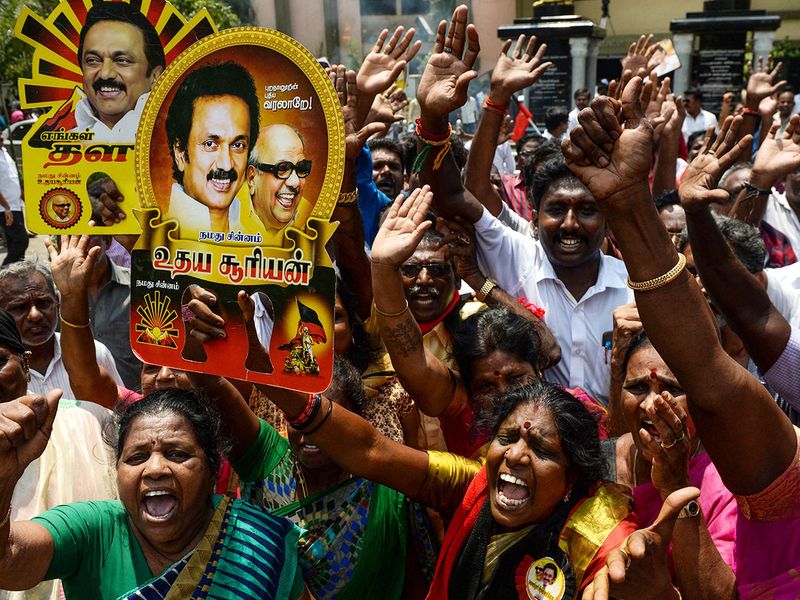
Current Deputy Speaker of Lok Sabha Thambi Durai is trailing against Jyothimani, who lost to him in 2014, from Karur, while Rajya Sabha MP Kanimozhi leads BJP’s Tamilisai Soundararajan in a high-profile contest in Tuticorin, which witnessed the agitation against the Sterlite plant. BJP’s sitting MP Pon. Radhakrishnan is also trailing in Kanyakumari to Congress candidate Vasanth Kumar, while another MP Anbumani Ramadoss of Pattali Makkal Katchi also trailing behind DMK’s Senthil Kumar in Dharmapuri. Karthi Chidambaram, son of former union Finance Minister and Home Minister P. Chidambaram, is also leading in Sivaganga against BJP’s H. Raja.
The much-anticipated effect of the breakaway AIADMK-group led by T.T.V. Dhinakaran, nephew of Sasikala, did not make the desired dent into to the AIADMK votes, while Kamal Haasan’s Makkal Needhi Maiam also did not live up to expectations, leaving the contests between the heavyweights DMK and AIADMK.
However, in the 22 by-elections for the State Assembly, the ruling AIADMK is faring much better as they are leading in 9, while the DMK alliance, led by M.K. Stalin, is ahead in 13. If this trend continues, the Edappadi K. Palaniswami-led government will be able to hold on to the majority and ward off the threat hanging over its head and will be able to continue until 2021.
BJP gains huge lead in Karnataka
By Jai Prasad V Rai, Copy Editor
The results in Karnataka were much on the expected lines as BJP took a huge lead over Congress and Janata Dal Secular alliance, which came to power in the state a year ago.
The current trend showed BJP was ahead in 24 of the state's 28 Lok Sabha seats with Congress and JDS managing just 3.
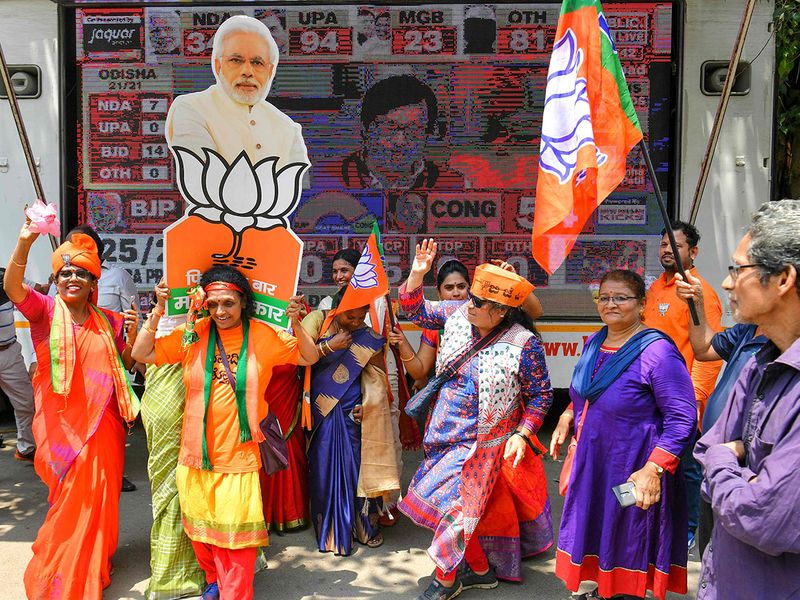
Among the high-profile candidates former Prime Minister and JDS supremo HD Devegowda contesting from Tumkur was trailing against BJP’s G S Basavaraj while his grandson Prajwal Revanna won in JDS stronghold Hassan. His another grandson Nikhil Kumarswamy is trailing against Sumalatha Ambareesh who is contesting from Mandya as an independent candidate.
BJP's newcomer and youngest candidate Tejasvi Surya of the BJP, is leading from Bangalore South constituency against the Congress's B.K Hariprasad.
The JDS-Congress coalition were struggling to keep the coalition afloat with internal rifts in the recent months. Recently Congress leader Roshan Baig vented his anger after the exit polls calling his party leadership in Karnataka "buffoons" and a "flop show". And with the huge setback in the LS results, the JDS-Congress coalition stares at a very likely collapse.
Clean sweep for NDA in Bihar
By Lata Rani, Correspondent
Patna: The Bhartiya Janata Party-led National Democratic Alliance (NDA) appears heading for a clean sweep in Bihar with the ruling alliance leading in over 38 of the 40 Lok Sabha seats.
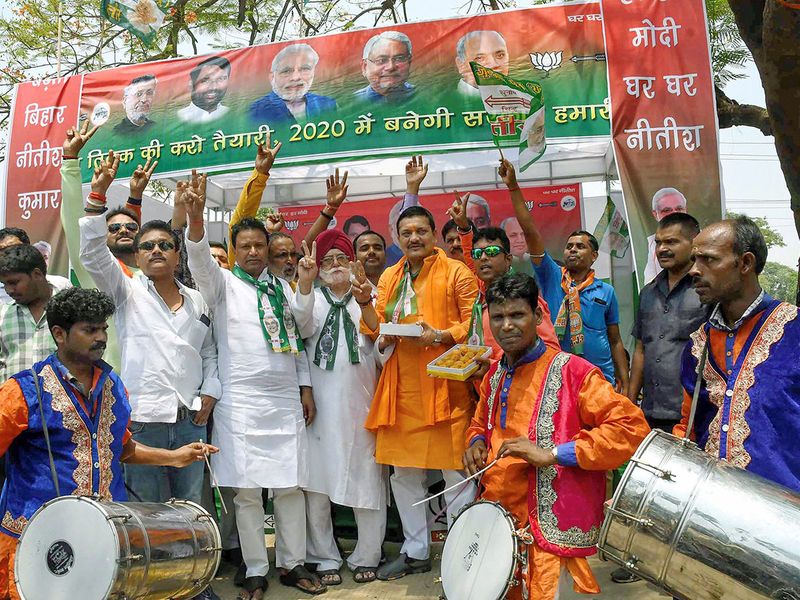
Both the BJP and the Janata Dal United (JD-U) are leading in over 16 seats while the Lok Janshakti Party (LJP) has established a lead over six seats. The JD-U and the LJP are headed by Bihar chief minister Nitish Kumar and Federal minister Ram Vilas Paswan respectively.
CPI candidate Kanhaiya Kumar and BJP-turned-Congress candidate Sahtrughan Sinha are both trailing in Begusarai and Patna Sahib seats to BJP candidates Giriraj Singh and Ravi Shankar Prasad.
A major setback for the opposition was the jailing of Rashtriya Janata Dal president Lalu Prasad and the courts repeatedly refusing to grant him bail. This left the lengthy poll campaign on the shoulder of the inexperienced Tej Pratap Yadav, Prasad’s younger son. He invested all his energy, addressed more than 250 election rallies but failed to bring about the desired results.
Jolt in Telangana
By Nagarjuna Rao, Senior Pages Editor
The biggest jolt for Telangana Rashtra Samiti, which has retained power in the December 2018 Assembly polls bagging 88 of the 120-seats, is Kalvakuntla Kavitha's likely defeat from Nizamabad Lok Sabha constituency. The TRS has exuded the confidence of winning 16 of the 17 LS seats leaving one seat for its ally All India Majlis Ittehadul Muslimeen (AIMIM).
But, as things stand now, the TRS will be restrained to a single digit winning just 9. The Bharatiya Janata Party is leading in 4 seats and the Congress, which had been nearly wiped out in the state elections is projected to bag 3 seats and AIMIM looks invincible in its traditional bastion of Old City in Hyderabad.

For Telangana Chief Minister K Chandrasekhar Rao, who aspired to play a kingmaker's role post-Lok Sabha elections with non-BJP and non-Congress led parties, the results will be a big blow.
In Andhra Pradesh, Jaganmohan Reddy's YSR Congress Party is sweeping the LS and Assembly polls. While the trends show he hasn't conceded a single LS seat to his main rival N Chandrababu Naidu's Telugu Desam Party (TDP), Tollywood star Pawan Kalyan has proved a non-starter. He has failed bitterly in the polls. The Jena Sean chief is unlikely to win a single seat, including for himself.
In the assembly polls too Jagan is looking at a massive 152-seat win in the 175-seat House while Naidu's TDP will have to be satisfied with just 23.
Bye bye Chandrababu Naidu?
By Malavika Kamaraju, Features Editor
The Andhra chief minister Chandrababu Naidu of the Telugu Desam Party (TDP) seems to be a in a spot. He seems to losing out to Jagan Mohan Reddy (YRS Congress Party) who seems to be headed for a hands-down victory. The tangled history of Andhra state, with the bifurcation of Andhra and Telangana in 2014, has riven deep fissures along the lines of identity and ethnicity as Naidu, once in alignment with the BJP, broke off ties last year expressing his displeasure with Prime Minister Narendra Modi’s indifference to granting the state a Special Category status.
It was the first time the party ventured out on its own without forging an alliance.

The Special Category status promised to Andhra Pradesh at the time of the rending of the state into two has yet to come to pass and the hiatus has been used well by Jagan Reddy to create the space for his ambitions. The protracted challenge of building the new Andhra capital Amravathi has become Naidu’s bete noire as issues of jobs and industrial slowdown dodge his term, as does the fact that he settled for a special sum for Andhra rather than stand form on the status category.
Jagan Reddy, on the other hand, probably aided by his relatively younger age, has canvassed indefatigably for his party across the state, going door to door and holding up to the light the failures of the Naidu government in an unrelenting campaign that seems to be yielding results. It also helps that he has the tacit support of Chief Minister of neighboring Telangana, K Chandrashekar Rao.
What is also working in Reddy’s favour is his focus on the backward castes which are a feed source of votes for the TDP.
Also, Reddy’s accessibility to the ground sentiment is stronger than Naidu’s and that could well be a new starting point for Andhra’s next political chapter.
The issue of Amravati and Special Status remain paramount and if he can pull off the latter for the state, he will be the role model for generations to come.
What is also working in Reddy’s favour is his focus on the backward castes which are a feed source of votes for the TDP and he seems to have successfully attracted them, proving that his accessibility to the ground sentiment is stronger than Naidu’s and that could well be a new starting point for Andhra’s next political chapter.
In the Kashmir valley, voters snub PDP
By Sadiq Shaban, Deputy Opinion Editor
As the vote count for Lok Sabha elections proceeds in the politically sensitive state of J&K, the verdict from the valley appears to be a clear snub to the People’s Democratic Party (PDP). The party, headed by Mehbooba Mufti, had won all three parliamentary seats in Kashmir in 2014, but then went on to form an alliance with the BJP in the state assembly.
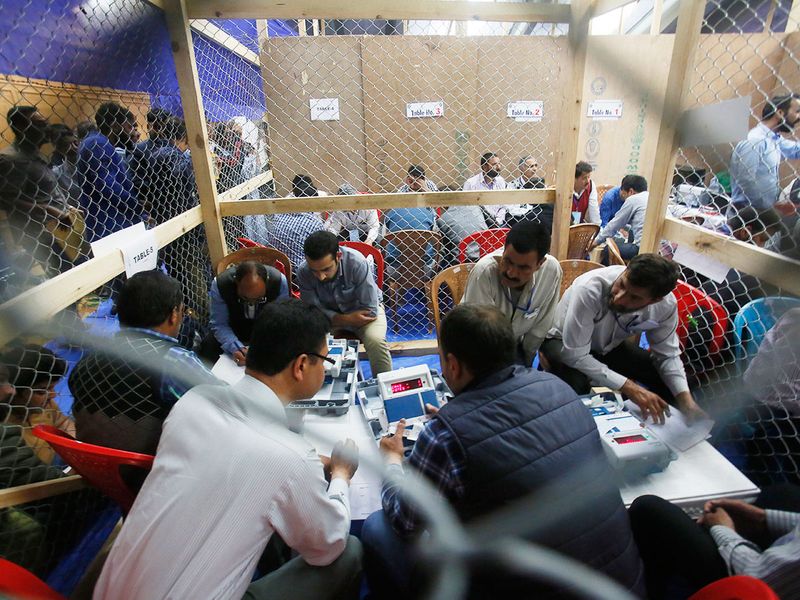
Today’s results point to a backlash by the electorate who appear to be sending a message to the regional party that its past alliance with the Hindu nationalist party was not forgotten by a majority of them. PDP’s main rival, National Conference, is leading in from the prestigious Srinagar constituency. The valley’s other two seats Baramulla and Anantnag constituencies are also going to the National Conference kitty while an Independent is leading from Ladakh. Both seats in the Jammu province look set to go to the BJP.
BJP-AGP alliance in Assam shows the way in Northeast
By Sanjib Kumar Das, Senior Pages Editor
The Northeast states have for a long time been a stronghold of regional parties with the Congress also playing a major role. However, the trend that has been noticed all over India seems to have gripped the Northeast as well, with the BJP and its allies set to do well in Assam, Arunachal Pradesh, Mizoram, Nagaland, Tripura and Manipur. Only in Sikkim the party is yet to get into the ‘leads’, but going by the current trends, the BJP looks set to win about 20 of the 25 seats on offer, with the lion’s share of those seats – 14 to be precise -- coming from Assam, where the BJP’s alliance partner Asom Gana Parishad (AGP) is also doing well.
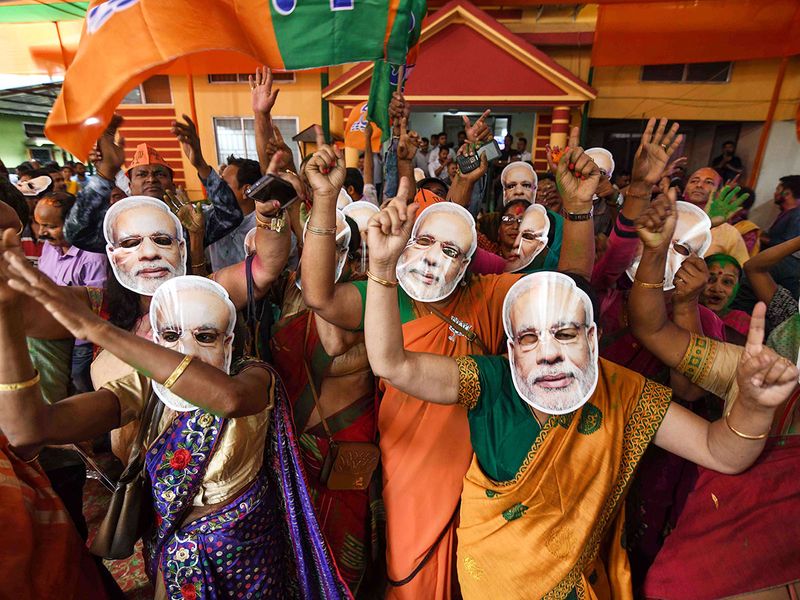
In fact, the way the BJP-AGP alliance is going in Assam, it is yet another instance of how well the BJP top brass has got its alliance politics and seat-sharing arrangement right. Just like the alliance with Shiv Sena in Maharashtra and Janata Dal (United) in Bihar, the BJP’s alliance with AGP in Assam is set to give the combination around 12 of the 14 seats in Assam.
Saffron tide means worrying times for Mamata in Bengal
By Chiranjib Sengupta, Assistant Editor
The BJP was widely expected to make major inroads in West Bengal this election – but it seems to have outdone itself.
With an expected tally of between 18 to 20 seats for the BJP, this is a shocker for West Bengal chief minister and Trinamool Congress (TMC) party chief Mamata Bannerjee. The TMC’s tally is expected to shrink by at least 10-15 seats and significantly reduce its leverage as an opposition party in the Indian parliament.
While most of the BJP’s gains are outside of the state capital Kolkata, in a further embarrassment to the TMC, BJP’s candidate Chandra Kumar Bose is leading in Kolkata South – the home constituency of Mamata Banerjee. That’s a seat that the TMC has been winning for eight consecutive terms, but the grand-nephew of Netaji Subhash Chandra Bose seems to have other plans.
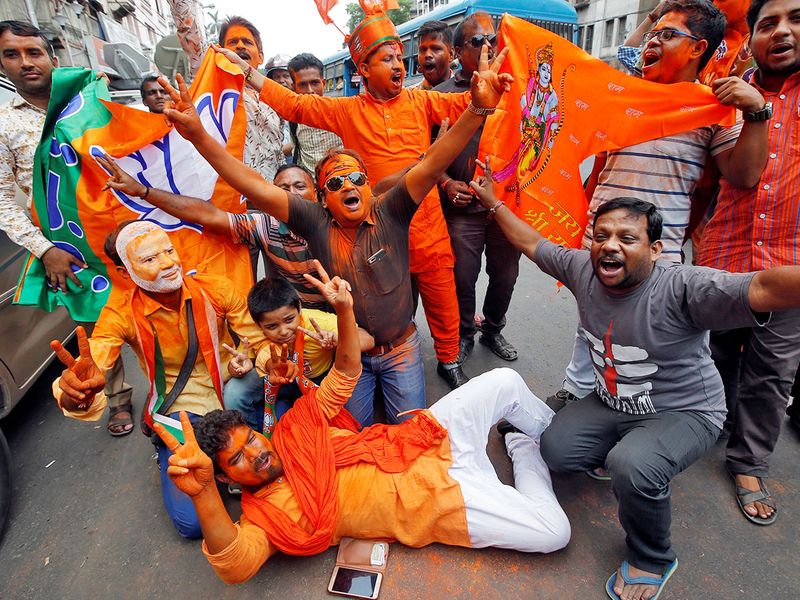
With such a thumping tally, the BJP is certainly going to push its case in Bengal – and Mamata should be worried about the stability of her government in the coming months. Although state assembly elections are not due until 2021, nothing can be taken for granted in Bengal – a state where the BJP and the RSS have systematically worked since 2014 to gain this stronghold. However, state assemblies are also a different affair altogether – as we can see from what’s happening in Odisha, where the BJP has made major gains for the parliamentary elections but is trailing badly in the state elections to Naveen Patnaik’s Biju Janata Dal.
The other shocker in Bengal is the CPIM – with zero seats so far in the state, it looks like the Left’s epitaph has been written in one of its last bastions.
Many would have seen it coming, especially in the context of the whisper campaigns by disgruntled and disillusioned Left workers in favour of the BJP. For the Left, despite the talk of a united front against the BJP at a national level, Mamata Bannerjee remained their enemy no. 1 in the state and their survival or progress depended on her ouster or a weakening of the TMC. Their wish may just have been granted by the BJP – at the cost of the CPM’s own oblivion.
Congress-led front set to sweep Kerala
By Shyam A. Krishna, Opinion Editor
The United Democratic Front (UDF), led by the Congress, looks set to win all the 20 seats in the southern state of Kerala. Only the Marxist (CPM) candidate A.M. Ariff in Alappuzha looks to be a position to prevent a clean sweep. With over 20 per cent seats counted, he seemed to have exchanged the lead with Congress’ Shanimol Usman several times. If the Congress-led UDF wins all the 20 seats, the Front will equal their best performance in 1977, the election that followed the Emergency. Congress President Rahul Gandhi and IUML’s Kunhalikutty are en route to massive victories. Congress’ Shashi Tharoor seems to thumb his nose at the exit poll predictions which forecast BJP’s maiden win through Kummanam Rajasekharan. At the moment, the BJP wave failed to reach Kerala.
Why UP’s Mahagathbandhan is trailing
By Bobby Naqvi, UAE Editor
When regional heavyweights Samajwadi Party and Bahujan Samaj Party joined hands in Uttar Pradesh, most analysts called it a formidable alliance capable of derailing Modi’s re-election bid.
That assessment was fair considering the combined vote share of the SP and the BSP. ‘Haathi, Lathi Aur Saat Sau Chiyasi’ (Elephant, Stick and 786) – a slogan that includes BSP’s polls symbol of elephant, SP vote bank Yadav community’s stick and 786, a number Muslims in India consider auspicious was seen as a potent combination.
However, today’s trends show that arithmetic was trounced by chemistry – the Modi magic has worked well in the state that sends 80 seats and is home to over 200 million people.
UP is one state where the Modi government has been able to deliver services to the last mile voter. Three things which stand out are toilets, houses and free cooking gas, a big bounty for the poor and marginalised people of the state where per capita income is one of the lowest in the country. In short, Modi’s image of a strong leader who is tough on national security, is winning a windfall.
An evenly poised fight in Jammu and Kashmir
Sadiq Shaban, Deputy Opinion Editor
National Conference president Farooq Abdullah is all set to retain his Srinagar Lok Sabha seat as early trends give him a solid lead over his rivals. According to the latest figures, Dr Abdullah is leading in Srinagar by more than 15361 votes. Mehbooba Mufti, the former chief minister of J&K, and the president of the People’s Democratic Party (PDP) is trailing in the sensitive Anantnag constituency. Both her rivals: National Conference’s Justice (retd) Hasnain Masoodi, and Ghulam Ahmad Mir of the Congress are ahead of her, going neck to neck in the south Kashmir constituency. From available trends this hour, BJP’s Jugal Kishore and Jitendra Singh may romp home with the Jammu and Udhampur parliamentary segments respectively.
Modi’s BJP looks set to better 2014 performance
By Bobby Naqvi, UAE Editor
Prime Minister Narendra Modi’s Bharatiya Janata Party (BJP) looks set to better its 2014 performance of 282 seats. Almost three hours after the counting began at 8am IST, the BJP had crossed 300 seats in trends while the NDA coalition that it leads is inching towards 350, 17 seats over its tally of 333 in 2014.
While this tally is still below the Congress’s best ever performance of 404 in 1984, the NDA touching 350 mark would be not just spectacular but unprecedented in recent decades. Remember, Modi’s 2014 victory with an absolute majority in a House of 543 was a first in almost three decades. Today, Modi’s party is heading for another record win.
Tectonic shift in Bengal
By Sanjib Kumar Das, Senior Pages Editor
It’s a tectonic shift in Bengal! It’s still early days, as counting is still on, but according to figures made available by the Election Commission, there is just a two percentage-point difference between the Trinamool Congress (TMC) and Bharatiya Janata Party (BJP) in Bengal in terms of vote share and that is something very surprising in a state where the BJP never managed anything beyond a 17 per cent vote share in a general election. According to the latest figures, in the 2019 general elections, the TMC has got 45 per cent of the votes, while BJP has garnered as much as 43 per cent. If this 43 per cent gets translated into seats, then the saffron brigade stands to win anything between 15-20 seats in West Bengal – a remarkable performance by any standards.
What this small difference in vote percentage between the TMC and BJP also shows is the kind of polarization that has taken place among Bengal voters this time. The state is clearly divided into two political camps right now – its just TMC and BJP, relegating the Left and Congress to also-rans.
Hindi Heartland
By Bobby Naqvi, UAE Editor
The ruling National Democratic Alliance looks set to repeat its performance in the Hindi heartland states of Madhya Pradesh, Rajasthan and Gujarat where the Prime Minister Narendra Modi’s Bharatiya Janata Party is locked in a direct fight with the Congress.
In all these states, the BJP was leading on most seats, a surprise comeback after losing to the Congress in assembly elections in December 2018. Voters in Rajasthan, where the BJP is leading on almost 24 seats out of 25, were expected to vote for Modi, making a clear distinction between state and national polls. Similarly, in Modi’s home state of Gujarat, the BJP looks set to capture most if not all seats. But the most surprising is the BJP’s big lead in MP where the Congress was expected to put up a good fight, here too the party is trailing.
NDA inches towards 350 mark
By Bobby Naqvi, UAE Editor
More than two hours after counting started in India, the ruling National Democratic Alliance is inching towards the 350 mark. From the beginning, it has maintained a handsome lead in key battleground states of northern India.
In Uttar Pradesh for example, the BJP is leading on 55 out of 80 seats, dealing a devastating blow to the opposition alliance called Mahagathbandhan.
If the NDA maintains this lead in the next two or three rounds, it would be safe to say that Prime Minister Narendra Modi is returning to power with a thumping majority.
The Congress-led United Progressive Alliance was trailing roughly at 110 plus seats, according to the trends projected by TV channels. It is projected to do well in the southern states of Kerala, Tamil Nadu and Punjab.
Giriraj Singh consolidates lead
Malavika Kamaraju, Features Editor
In Begusarai, a key battleground in Bihar, the controversial BJP minister Giriraj Singh has consolidated his lead polling 82,364 votes while Kanhaiya Kumar, a former President of Jawaharlal Nehru University Students' Union (JNUSU), of the CPI is trailing with 39,206 votes.
When touchpoints trumped chemistry
By Sanjib Kumar Das, Senior Pages Editor
Every general election in India, right from the first one in 1952, has had its own narrative. And by and large, the results have gone with the dominant narrative of the day. The first exception to this ‘normal’ was in 2004, when the Bharatiya Janata Party (BJP) lost power in spite of its high-decibel ‘India shining’ campaign and in spite of a perceived positive voter-sentiment for the prime minister of the day, Atal Bihari Vajpayee. Subsequently, in 2009 and in 2014, the fate of the elections went along predictable lines. In that sense, the results of the 2019 general elections have come as more of a shock and surprise – whether pleasant or unpleasant will depend upon which side of the political divide one is in. The narrative for the run-up to the elections and during the six weeks of campaigning was very much for Congress president Rahul Gandhi to seize the moment and say it once and for all – ‘I have arrived’. The vituperative campaign rhetoric unleashed by the BJP rank and file -- including Prime Minister Narendra Modi himself, and the likes of Pragya Thakur, the BJP candidate from Bhopal -- set the bar so low that it will take quite sometime for the dust to settle down on this vicious tongue-trail that made personal-attacks look like a new normal.
The jobs data wasn’t really singing a happy tune. In addition, shoddy handling of the demonetisation policy and the hurried implementation of the goods and services tax (GST) were just a few of the reasons for a pollster not to put his or her money behind the saffron brigade. In short: The Bunsen burner of anti-incumbency was all set to fire up the chemistry for a non-BJP government at the Centre.
And yet, these results!
So where did things go wrong for India’s Opposition? Or shall we say, how did BJP manage to be spot-on?
From the Kisan Samman Siddhi (a grant of Rs6,000 or Dh316 to every farmer who owns five acres of land) to ten per cent reservation in jobs for the economically backward upper caste members; from Swachh Bharat (Clean India) to Pradhan Mantri Ujjwala Yojana (the scheme to provide gas cylinders for cooking to women living below the poverty line) … the list is long. In five years of its rule at the Centre, the Modi-led dispensation rolled out one scheme after another that were all a part of a very carefully curated outreach plan aimed at the most impoverished sections of the society. Some of these were hobbled with logistical shortcomings right from their inception. For instance, Swachh Bharat. Under this project, more than 30 million toilets have been constructed in the country since 2014 to put an end to open defecation. However, in the 2017-2018 financial year, while Rs1.39 trillion was earmarked for construction of public toilets, the allocation for rural water infrastructure development was only Rs60 billion. Common sense says that in the absence of adequate water supply, many of these toilets will merely be edifices of a grandiose state plan hamstrung with teething trouble.
And yet, in several villages of poll-bound eastern Uttar Pradesh, India’s largest state by size and population, there were reportedly a large number of voters – women in particular – for whom, the neighbourhood toilet built under Swachh Bharat constituted one of the most tangible signs of the Modi government’s commitment to social justice for the poorest of the poor. According to unofficial estimates, more than 200 people across India lost their lives for various reasons and circumstances connected to Modi’s demonetisation drive in November 2016. And yet, while thousands of people were made to wait for several hours in serpentine queues as ATMs ran out of cash, many were still seen thanking Modi for his ‘surgical strike’ on hoarders of black money.
That has really been the story of five years of Modi rule at the Centre. The optics were weaved so deftly into the tangibles that for the vast majority of India’s voters it was almost sacrilege not to have allowed Modi a second term in office. And this is where the Congress and all other Opposition parties came a cropper – they had neither the optics nor the tangibles to make a potent election pitch. Rahul’s much tom-tommed minimum income guarantee scheme -- Nyay -- that promised to provide an annual grant of Rs72,000 to 20 per cent of the poorest families, was just that – a scheme, with little to show for its efficacy on the ground. Obviously, being out of power, it couldn’t have done anything more than make an offer on paper to placate voter sentiment. Even the ‘Modi-vs-The Rest’ rhetoric that the Opposition tried to build so assiduously around its campaign was flawed to its core: It tried to pit a concept, that of a united Opposition, against a tangible, that was Modi!
The recipe was indeed in place for a heady concoction of ‘secular’ forces to neutralise the after-taste of a ‘communal’ BJP. But the point is, that LPG cylinder in one corner is a more potent reminder of what the source of the fire-power has always been to get the kitchen up and running, in the first place!
The ‘touchpoints’ of Swachh Bharat, Ujjwala … have pipped Rahul to the post.


